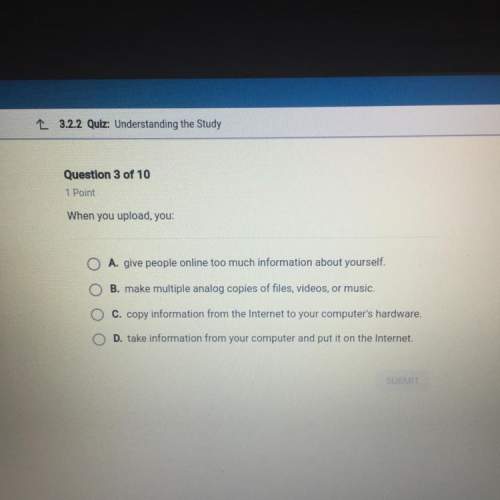
Computers and Technology, 10.05.2021 18:20 jech3947
The goal of this project is to give you some hands-on experience with implementing a small compiler. You will write a compiler for a simple language. You will not be generating assembly code. Instead, you will generate an intermediate representation (a data structure that represents the program). The execution of the program will be done after compilation by interpreting the generated intermediate representation.
1 Introduction You will write a small compiler that will read an input program and represent it in an internal data structure. The data structure consists of two parts: (1) a representation of instructions to be executed and (2) a representation of the memory of the program (locations for variables). Instructions are represented by a data structure that includes the operand(s) of the instruction (if any) and that specify the next instruction to be executed. After the data structures are generated by your compiler, your compiler will execute the generated instructions representation by interpreting it. This means that the program will traverse the data structure and at every node it visits, it will execute the node by changing the content of memory locations corresponding to operands and deciding what is the next instruction to execute (program counter). The output of your compiler is the output that the input program should produce. These steps are illustrated in the following gure 1 The remainder of this document is organized as follows: 1. Grammar Denes the programming language syntax including grammar.
2. Execution Semantics Describe statement semantics for if, while, switch and print state- ments.
3. How to generate the intermediate representation Explains step by step how to generate the intermediate representation (data structure). You should read this sequentially and not skip around.
4. Executing the intermediate representation Basically, you have two options. If you are using C/C++, you should use the code we provide to execute the intermediate representation. If you are using Java, it describes the strict rules to follow in executing the intermediate representation. Those rules will be enforced.
5. Requirements Lists the programming languages you are allowed to use in your solution (C/C++ or Java) and other requirements.
6. Grading Describes the grading scheme.
7. Bonus Project Describes the requirements for the bonus project. 2 Grammar The grammar for this project is a simplied form of the grammar from the previous project, but there are a couple extensions.

Answers: 3
Another question on Computers and Technology

Computers and Technology, 23.06.2019 09:10
Effective character encoding requires standardized code. compatible browsers. common languages. identical operating systems.
Answers: 1

Computers and Technology, 24.06.2019 14:00
Fast answer i need for apex ! smartphones should be banned from the classroom in public schools so that students cannot cheat on test so easily? which is an example of a counter argument to the thesis above? a.the classroom is a place for learning not for making phone calls b. smartphones are useful learning tools in the modern classroom c.banning smartphones will not students pay attention to teachers any better d. banning smartphones would decreased incidents of theft
Answers: 2

Computers and Technology, 25.06.2019 08:10
Why should the technician watch for signs of contamination in the oil when recovering refrigerant from a system
Answers: 3

Computers and Technology, 25.06.2019 19:30
How do i do a mail merge in word and access.
Answers: 1
You know the right answer?
The goal of this project is to give you some hands-on experience with implementing a small compiler....
Questions


Mathematics, 26.02.2021 23:40


Mathematics, 26.02.2021 23:40



Mathematics, 26.02.2021 23:40

Mathematics, 26.02.2021 23:40

Advanced Placement (AP), 26.02.2021 23:40

Mathematics, 26.02.2021 23:40


Social Studies, 26.02.2021 23:40

Mathematics, 26.02.2021 23:40

Physics, 26.02.2021 23:40

Physics, 26.02.2021 23:40


Biology, 26.02.2021 23:40



History, 26.02.2021 23:40




